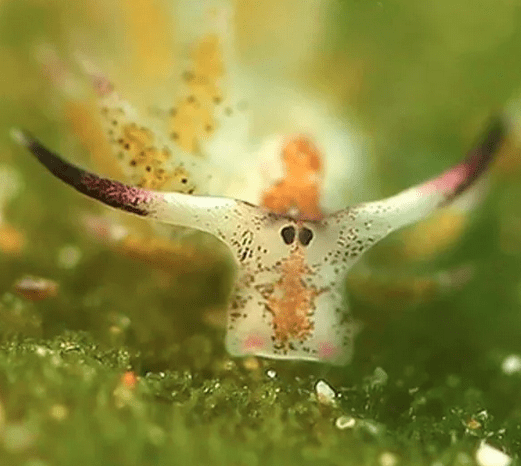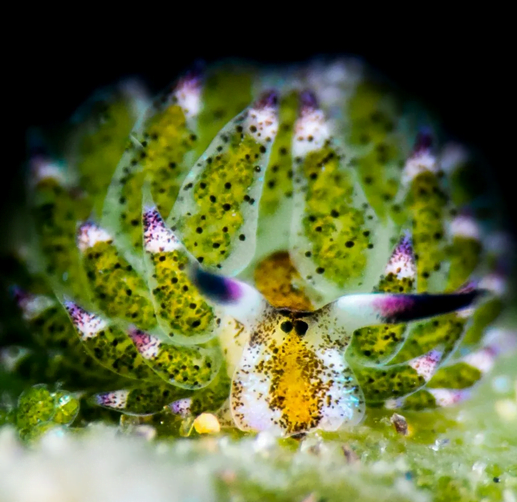Are you ready to dive into the world of leaf sheep, one of the most mesmerizing sea creatures in the world? These tiny creatures have a unique feature that only exhibits in plants. So what is it and how do they do this? Let’s dive into leaf sheep facts and find the answer!
Phylum: Mollusca
Class: Gastropoda
Order: Sacoglassa
Family: Costasiellidae
Genus: Costasiella
1. Leaf sheep are not sheep
Called leaf sheep, this species is not actually a sheep. It’s a type of sea slug that have a small size, about an inch or just over 5mm in length. Along with the sea bunny, leaf sheep are among the cutest species in the ocean world. However, unlike the sea bunny, they are not poisonous or venomous.
The sheep in the sea features a cream-white, jelly body that appears almost transparent, complemented by two black eyes. Its black rhinophores on either side of the head resemble a sheep’s ears and function similarly to insect antennae. The small hairs in these rhinophores help the sea slug detect compounds in the water, allowing it to locate food and avoid danger.

The leaf sheep’s entire body is adorned with numerous green cerata, which are branching digestive glands. If you look closely at this sea slug, you’ll find these glands look like zebra succulent or aloe vera leaves. However, these leaves have white, purple, or pink endings. These green structures have been compared to sheep’s wool by some people.
While the majority of leaf sheep are green, it is believed that they also come in different colors.

2. Habitat
Leaf sheep sea slug was initially discovered in the Japanese islands in 1993 and this is their main habitat. However, recent research has revealed that these sea slugs have also been found in other locations like Northern Australia, Indonesia, Singapore, and the Philippines.

Costasiella is the genus name for all sea slugs in the sacoglossa group. Kuroshimae is derived from a Japanese island off the coast of Taiwan where the species was first found in 1993.
3. They can photosynthesize
Leaf sheep are not plants, they are sea slugs. However, this species can photosynthesize like plants. This is a process that uses sunlight to manufacture all of the nutrients required from carbon dioxide and water. The photosynthesis carried out by these unique species is known as kleptoplasty.

So, how do these sea slugs do this?
Leaf sheep primarily consume sea algae. During this process, they retain some of the algae’s chloroplasts in their cerata tissues for up to 10 days. Subsequently, they use these chloroplasts to convert light energy into usable energy, just like plants. With the capability to perform photosynthesis, these ocean sheep can survive solely on solar energy for up to 2 months.

All the members of the Sacoglossa order can exhibit this technique. That’s why they are called “solar-powered sea slugs.”
4. They graze food
Sea sheep, along with other sea slug species, are strictly herbivorous. They primarily feed on algae. Specifically, they rely on Avrainvillea, a soft and velvety type of algae that flourishes on soft surfaces such as fine sand or silt.
These sheep leaf slugs store the chloroplasts within the algae and then enrich their food with the kleptoplasty function. We talked about this above. This provides enough energy for their sustenance.

Leaf sheep can protect themselves by eating algal chloroplasts. This substance not only gives them a green hue that they can use to blend into their surroundings but also offer a chemical defense mechanism against predators.
The most intriguing aspect of their eating habits is how they consume algae. They break the algae’s cell walls, then hold it near to their mouth to take all of its nutrients. Rather than digesting the entire nutrients, green sheep sea slugs save only the chloroplast and keep it within their body for later use. This feeding process is comparable to that of the sea slug species Elysia chlorotica.

5. They have 2 reproductive organs
Like other sea slugs, the leaf sheep possesses both male and female reproductive organs. And they still need a partner to reproduce. When they meet a suitable mate, they collaborate to generate a large number of eggs.

The sheep of the sea can remain in this form for up to two weeks until they mature into a sea slug. The usual lifespan of this species is expected to be between 2-3 years.
6. They’re at risk
Leaf sheep are not listed as Endangered by the IUCN list. However, their survival is still threatened by a variety of factors, including habitat loss.
Destructive practices like illegal fishing, as well as the use of harmful techniques such as dynamite or cyanide, can severely damage marine ecosystems and harm the animals that live there, including leaf sheep.

Climate change is also another factor. The habitat of sea slugs is also being affected by climate change. The warming and acidification of the oceans could have an impact on the behavior of these animals. Their foraging success is lower and decision-making is poorer.
These sea slugs are also affected by plastic pollution. Microplastics may clog a leaf sheep’s mouth or build in its digestive system, and the toxins pouring out may damage its health.

References:

